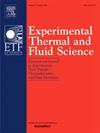Experimental study on the effects of turbulence intensity on the aeroelastic stability of wind turbine airfoils
IF 2.8
2区 工程技术
Q2 ENGINEERING, MECHANICAL
Experimental Thermal and Fluid Science
Pub Date : 2025-03-03
DOI:10.1016/j.expthermflusci.2025.111457
引用次数: 0
Abstract
The trend toward larger wind turbines also makes the aeroelastic stability of ultra-long flexible blades more sensitive to environmental excitations such as turbulence intensity. Using a specialized airfoil designed for large wind turbines as the research subject, synchronized wind tunnel tests of vibration and pressure were performed to systematically study the effects of turbulence intensity on the aeroelastic stability of the airfoil and to explore its underlying mechanisms. The results showed that different values of incoming turbulence intensity had opposite effects on the aeroelastic response of the airfoil. Accordingly, the environment with different turbulence intensities was divided into zones: turbulence-promoting vibration zone, transition zone, and turbulence-suppressing vibration zone. In the turbulence-promoting vibration zone, the appearance from the leading-edge vortex triggered stall flutter in the airfoil, and the stall flutter was restricted to the specific wind speed scope. As the turbulence intensity increased, the wind speed scope for stall flutter advanced and expanded. In the transition zone, the airfoil’s torsional vibration characteristics became extremely complex, and four types of aeroelastic responses were observed: small amplitude random aeroelastic response, stall flutter, special dual-frequency vibration, and buffeting caused by turbulence excitation. In the turbulence-suppressing vibration zone, high turbulence intensity significantly suppressed the separation of the boundary layer at the airfoil’s suction surface, while only two types of aeroelastic responses were observed, corresponding to the first small amplitude random aeroelastic response and the fourth buffeting caused by turbulence excitation in the transition zone, with the amplitude of buffeting significantly smaller than that in the transition zone.
湍流强度对风力机翼型气动弹性稳定性影响的实验研究
大型风力涡轮机的发展趋势也使得超长柔性叶片的气动弹性稳定性对湍流强度等环境激励更加敏感。以某大型风力机专用翼型为研究对象,进行了振动与压力同步风洞试验,系统研究了湍流强度对翼型气动弹性稳定性的影响,并探讨了其机理。结果表明,不同来流强度对翼型气动弹性响应的影响相反。据此,将不同湍流强度的环境划分为促进湍流振动区、过渡区和抑制湍流振动区。在促湍流振动区,前缘涡的出现引发了翼型的失速颤振,失速颤振被限制在特定的风速范围内。随着湍流强度的增大,失速颤振的风速范围增大和扩大。在过渡区,翼型的扭转振动特性变得极其复杂,观察到四种气动弹性响应:小幅随机气动弹性响应、失速颤振、特殊双频振动和湍流激励引起的抖振。在湍流抑制振动区,高湍流强度明显抑制了翼型吸力面边界层的分离,而只观察到两种气动弹性响应,对应于第一种小振幅随机气动弹性响应和第四种由过渡区湍流激励引起的抖振,抖振幅度明显小于过渡区。
本文章由计算机程序翻译,如有差异,请以英文原文为准。
求助全文
约1分钟内获得全文
求助全文
来源期刊

Experimental Thermal and Fluid Science
工程技术-工程:机械
CiteScore
6.70
自引率
3.10%
发文量
159
审稿时长
34 days
期刊介绍:
Experimental Thermal and Fluid Science provides a forum for research emphasizing experimental work that enhances fundamental understanding of heat transfer, thermodynamics, and fluid mechanics. In addition to the principal areas of research, the journal covers research results in related fields, including combined heat and mass transfer, flows with phase transition, micro- and nano-scale systems, multiphase flow, combustion, radiative transfer, porous media, cryogenics, turbulence, and novel experimental techniques.
 求助内容:
求助内容: 应助结果提醒方式:
应助结果提醒方式:


